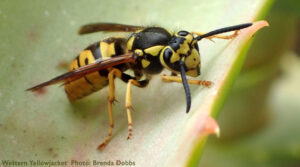
Every year around this time, yellowjacket swarms can be seen across Conroe and Montgomery county. Yellowjackets are a type of wasp, with venomous stings. While they are not normally aggressive unless their nests is threatened, it is important to know the basics about them for your safety as well as your pets’. But what do Yellowjackets look like? How can you tell the difference between them and other flying insects? What should you do if you’re stung? Those are all questions we aim to answer for you in the below article. Keep reading!
What Do Yellowjackets Look Like?
Yellowjackets are a species of wasp whose main hive or colony is underground. They are typically about ½ to ¾ of an inch long. Their bodies are black with yellow markings near the abdomen, and their wings are clear or yellow/orange. Their heads are typically brown or black, and often shiny.
How Can You Tell The Difference Between Yellowjackets and Bees?
Yellowjackets are different from bees in several ways. For one, they have no hairy body. They also do not have the ability to sting more than once, like bees can. (Bees collect and store pollen in their bodies that induce the stinging response when they feel threatened)
Yellowjackets also do not die after stinging, like bees often do. Yellowjacket nests are typically found in the ground or under objects such as decks, barbecue grills, etc.
What Causes The Yellowjacket Swarms?
Although it isn’t known for sure, some experts believe that the swarming of yellowjackets is directly related to mating. They feel that, in order for the queen to lay new eggs, she has to leave the nest and find a male wasp to mate with. After mating, she returns to her nest and lays eggs.
Where Do Yellowjackets Nest?
Yellowjackets build their nests underground, typically in moist soil. This is because their prey-many of which are bees themselves-need a healthy hive to be healthy enough to attack and bring back to the nest. The nests are made of paper and grass, and can be as small as a basketball or as large as a football. The adults typically die at the end of the summer, and the pups or larvae that emerge out of their eggs will develop into workers.
The yellowjacket’s life cycle starts with a fertilized queen, who hibernates over the winter and emerges in spring to build a nest out of chewed-up wood fibers mixed with her saliva. She will lay eggs and raise the first batch of larvae on her own, while the other yellowjackets in the hive go out and forage. Larvae will pupate to become adult workers, who take over colony maintenance while still allowing the queen to lay eggs. This cycle repeats itself until fall comes when yellowjacket populations decline.
The swarms people see in Conroe are usually just yellowjacket workers, who were foraging and not thinking about the location of their nest when they accidentally bump into people.
What Should I Do If Yellowjackets Are Near My Home?
If you find a yellowjacket swarm in the vicinity of your home or office, keep watch to see if any workers return. If so, you can remove them yourself by following these steps:
1. Get a can of wasp and hornet spray.
2. Spray the entrance to the nest and as many yellowjackets as you can, but keep a safe distance away from them (5 or 6 feet). They will become dazed and confused and then die quickly if not washed away by rain.
3. Repeat this process until all of the yellowjackets are dead.
4. Contact a pest control company to remove the nest after it has been treated several times with insect spray.
What Should I Do If Stung By A YellowJacket?
If you find yourself stung by a wasp or bee, do not panic! The stingers contain venom sacs that release only 0.25 mg of venom at a time-your body will safely absorb it. Remove the stinger by scraping along a hard surface, and cleanse the area with soap and water. If the sting feels worse than a bee sting or is accompanied by hives or other symptoms, seek medical attention immediately!
If you have pets, make sure they are up to date on their shots before they go outside. Most dogs are stung by yellowjackets just once or twice before they learn to avoid them. Cats, on the other hand, cannot defend themselves and will likely die from more than one wasp sting. If your cat is stung, take it to a veterinarian immediately!
If you have children, be careful not to let them play too close to yellowjacket nests. It is better to be safe than sorry!
What Should I Do If I Am Experiencing A Problem With Yellowjackets?
You should call CPL Pest Control! We promise to rid your home and yard of Yellowjackets! There is no reason why you should have to fight with yellowjackets this winter. Trust the professionals, trust the experts, trust CPL Pest Control! Call today for your FREE Consultation and Quote! Call 281-683-6737, as always, ask for Chris!
Thanks for reading!
